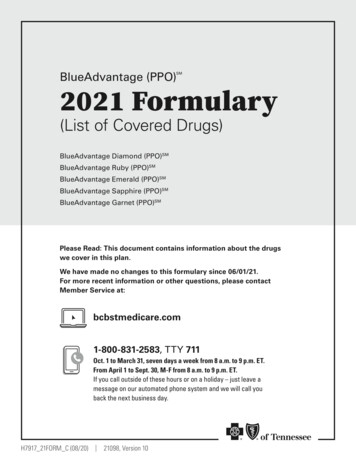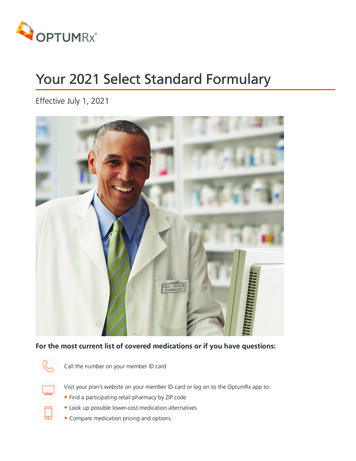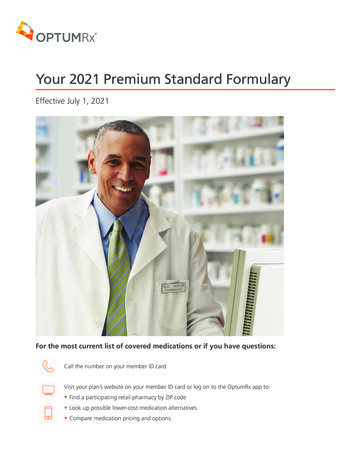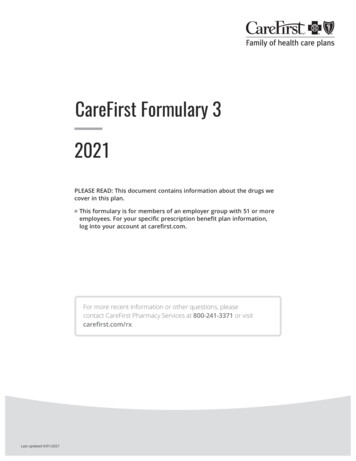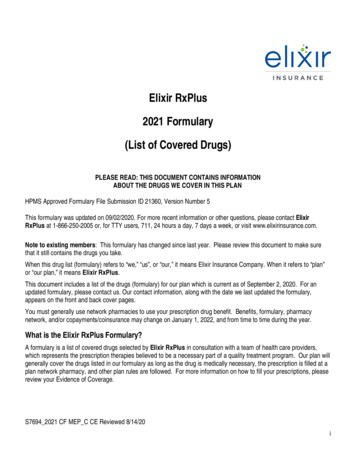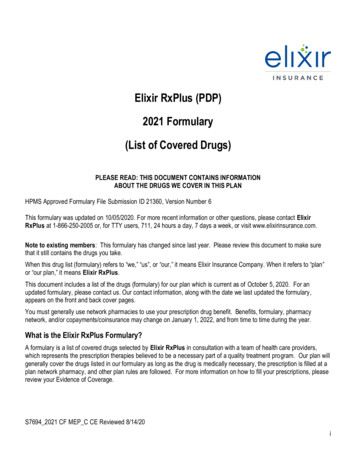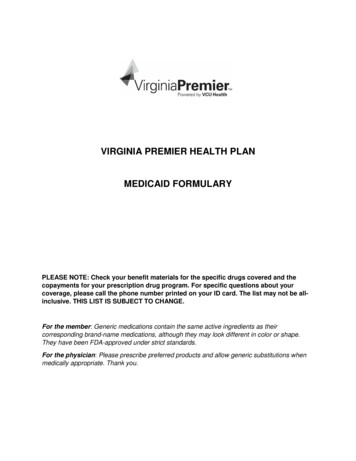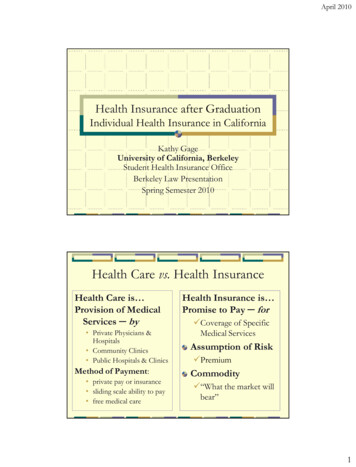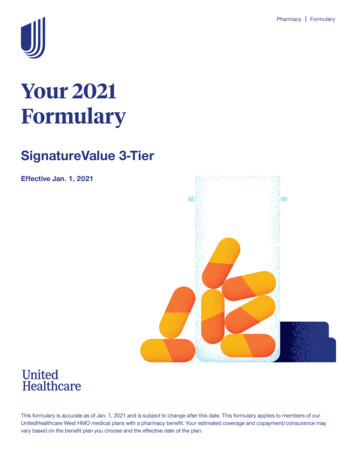
Transcription
Pharmacy FormularyYour 2021FormularySignatureValue 3-TierEffective Jan. 1, 2021This formulary is accurate as of Jan. 1, 2021 and is subject to change after this date. This formulary applies to members of ourUnitedHealthcare West HMO medical plans with a pharmacy benefit. Your estimated coverage and copayment/coinsurance mayvary based on the benefit plan you choose and the effective date of the plan.
Table of contentsUnderstanding your formulary. . . . . . . . . . . . . . . . . . . . . . . . . . . . . . . . . . . . . . . . . . . . . 4Medication tips . . . . . . . . . . . . . . . . . . . . . . . . . . . . . . . . . . . . . . . . . . . . . . . . . . . . . . . . . 5Reading your formulary . . . . . . . . . . . . . . . . . . . . . . . . . . . . . . . . . . . . . . . . . . . . . . . . . . 6Questions . . . . . . . . . . . . . . . . . . . . . . . . . . . . . . . . . . . . . . . . . . . . . . . . . . . . . . . . . . . . . 7Anti-InfectivesAntibiotics. . . . . . . . . . . . . . . . . . . . . . . . . . . . . . . . . . . . . . . . . . . . . . . . . . . . . . . . . . . . 8Antifungals. . . . . . . . . . . . . . . . . . . . . . . . . . . . . . . . . . . . . . . . . . . . . . . . . . . . . . . . . . . 8Antivirals . . . . . . . . . . . . . . . . . . . . . . . . . . . . . . . . . . . . . . . . . . . . . . . . . . . . . . . . . . . . 9Cancer . . . . . . . . . . . . . . . . . . . . . . . . . . . . . . . . . . . . . . . . . . . . . . . . . . . . . . . . . . . . . . . . 9Cardiovascular/Heart DiseaseCoagulation Therapy. . . . . . . . . . . . . . . . . . . . . . . . . . . . . . . . . . . . . . . . . . . . . . . . . .High Blood Pressure. . . . . . . . . . . . . . . . . . . . . . . . . . . . . . . . . . . . . . . . . . . . . . . . . .High Cholesterol . . . . . . . . . . . . . . . . . . . . . . . . . . . . . . . . . . . . . . . . . . . . . . . . . . . . .Other. . . . . . . . . . . . . . . . . . . . . . . . . . . . . . . . . . . . . . . . . . . . . . . . . . . . . . . . . . . . . . .10101112Central Nervous SystemAttention Deficit Disorder. . . . . . . . . . . . . . . . . . . . . . . . . . . . . . . . . . . . . . . . . . . . . .Depression. . . . . . . . . . . . . . . . . . . . . . . . . . . . . . . . . . . . . . . . . . . . . . . . . . . . . . . . . .Migraine . . . . . . . . . . . . . . . . . . . . . . . . . . . . . . . . . . . . . . . . . . . . . . . . . . . . . . . . . . . .Multiple Sclerosis. . . . . . . . . . . . . . . . . . . . . . . . . . . . . . . . . . . . . . . . . . . . . . . . . . . . .Other. . . . . . . . . . . . . . . . . . . . . . . . . . . . . . . . . . . . . . . . . . . . . . . . . . . . . . . . . . . . . . .Sedatives/Hypnotics. . . . . . . . . . . . . . . . . . . . . . . . . . . . . . . . . . . . . . . . . . . . . . . . . .Seizure Disorders . . . . . . . . . . . . . . . . . . . . . . . . . . . . . . . . . . . . . . . . . . . . . . . . . . . .12121313131414Dermatology. . . . . . . . . . . . . . . . . . . . . . . . . . . . . . . . . . . . . . . . . . . . . . . . . . . . . . . . . . 14DiabetesBlood Glucose Monitoring. . . . . . . . . . . . . . . . . . . . . . . . . . . . . . . . . . . . . . . . . . . . . 15Insulin. . . . . . . . . . . . . . . . . . . . . . . . . . . . . . . . . . . . . . . . . . . . . . . . . . . . . . . . . . . . . . 16Non-Insulin. . . . . . . . . . . . . . . . . . . . . . . . . . . . . . . . . . . . . . . . . . . . . . . . . . . . . . . . . . 16EndocrineGrowth Hormone. . . . . . . . . . . . . . . . . . . . . . . . . . . . . . . . . . . . . . . . . . . . . . . . . . . . . 17Other. . . . . . . . . . . . . . . . . . . . . . . . . . . . . . . . . . . . . . . . . . . . . . . . . . . . . . . . . . . . . . . 17Thyroid Hormone Replacement. . . . . . . . . . . . . . . . . . . . . . . . . . . . . . . . . . . . . . . . . 17Eye ConditionsAllergies . . . . . . . . . . . . . . . . . . . . . . . . . . . . . . . . . . . . . . . . . . . . . . . . . . . . . . . . . . . .Antibiotics. . . . . . . . . . . . . . . . . . . . . . . . . . . . . . . . . . . . . . . . . . . . . . . . . . . . . . . . . . .Glaucoma. . . . . . . . . . . . . . . . . . . . . . . . . . . . . . . . . . . . . . . . . . . . . . . . . . . . . . . . . . .Other. . . . . . . . . . . . . . . . . . . . . . . . . . . . . . . . . . . . . . . . . . . . . . . . . . . . . . . . . . . . . . .17171818GastrointestinalAcid Suppression . . . . . . . . . . . . . . . . . . . . . . . . . . . . . . . . . . . . . . . . . . . . . . . . . . . . 18Nausea/Vomiting. . . . . . . . . . . . . . . . . . . . . . . . . . . . . . . . . . . . . . . . . . . . . . . . . . . . . 18Other. . . . . . . . . . . . . . . . . . . . . . . . . . . . . . . . . . . . . . . . . . . . . . . . . . . . . . . . . . . . . . . 19HIV/AIDS. . . . . . . . . . . . . . . . . . . . . . . . . . . . . . . . . . . . . . . . . . . . . . . . . . . . . . . . . . . . . . 19Infertility. . . . . . . . . . . . . . . . . . . . . . . . . . . . . . . . . . . . . . . . . . . . . . . . . . . . . . . . . . . . . . 20Inflammatory Conditions: Rheumatoid Arthritis, Crohn’s Disease, Psoriasis,Ulcerative Colitis . . . . . . . . . . . . . . . . . . . . . . . . . . . . . . . . . . . . . . . . . . . . . . . . . . . . . 20Medications for Sexual Dysfunction. . . . . . . . . . . . . . . . . . . . . . . . . . . . . . . . . . . . . . . 202
Men’s HealthProstate. . . . . . . . . . . . . . . . . . . . . . . . . . . . . . . . . . . . . . . . . . . . . . . . . . . . . . . . . . . . . 20Testosterone Therapy. . . . . . . . . . . . . . . . . . . . . . . . . . . . . . . . . . . . . . . . . . . . . . . . . 21Miscellaneous. . . . . . . . . . . . . . . . . . . . . . . . . . . . . . . . . . . . . . . . . . . . . . . . . . . . . . . . . 21MusculoskeletalOsteoporosis. . . . . . . . . . . . . . . . . . . . . . . . . . . . . . . . . . . . . . . . . . . . . . . . . . . . . . . . 22Other. . . . . . . . . . . . . . . . . . . . . . . . . . . . . . . . . . . . . . . . . . . . . . . . . . . . . . . . . . . . . . . 22Pain Relief. . . . . . . . . . . . . . . . . . . . . . . . . . . . . . . . . . . . . . . . . . . . . . . . . . . . . . . . . . . 22Overactive Bladder. . . . . . . . . . . . . . . . . . . . . . . . . . . . . . . . . . . . . . . . . . . . . . . . . . . . . 23RespiratoryAsthma/COPD. . . . . . . . . . . . . . . . . . . . . . . . . . . . . . . . . . . . . . . . . . . . . . . . . . . . . . .Nasal Allergies. . . . . . . . . . . . . . . . . . . . . . . . . . . . . . . . . . . . . . . . . . . . . . . . . . . . . . .Oral Allergies. . . . . . . . . . . . . . . . . . . . . . . . . . . . . . . . . . . . . . . . . . . . . . . . . . . . . . . .Pulmonary Arterial Hypertension. . . . . . . . . . . . . . . . . . . . . . . . . . . . . . . . . . . . . . . .23242424Smoking Cessation. . . . . . . . . . . . . . . . . . . . . . . . . . . . . . . . . . . . . . . . . . . . . . . . . . . . . 24Transplant. . . . . . . . . . . . . . . . . . . . . . . . . . . . . . . . . . . . . . . . . . . . . . . . . . . . . . . . . . . . 24Vitamins/Electrolytes . . . . . . . . . . . . . . . . . . . . . . . . . . . . . . . . . . . . . . . . . . . . . . . . . . . 24Women’s HealthContraceptives. . . . . . . . . . . . . . . . . . . . . . . . . . . . . . . . . . . . . . . . . . . . . . . . . . . . . . .Hormone Replacement. . . . . . . . . . . . . . . . . . . . . . . . . . . . . . . . . . . . . . . . . . . . . . . .Miscellaneous . . . . . . . . . . . . . . . . . . . . . . . . . . . . . . . . . . . . . . . . . . . . . . . . . . . . . . .Prenatal Vitamins. . . . . . . . . . . . . . . . . . . . . . . . . . . . . . . . . . . . . . . . . . . . . . . . . . . . .25272727Index. . . . . . . . . . . . . . . . . . . . . . . . . . . . . . . . . . . . . . . . . . . . . . . . . . . . . . . . . . . . . . . . . 283
Understanding your formularyWhat is a formulary?This document is a list of the most commonly prescribed medications. It includesboth brand-name and generic prescription medications approved by the Food andDrug Administration (FDA). Medications are listed by common categories or classesand placed in tiers that represent the cost you pay out-of-pocket. They are thenlisted in alphabetical order.How do I use my formulary?You and your doctor can consult the formulary to help you select the most costeffective prescription medications. This guide tells you if a medication is generic ora brand name, and if there are coverage requirements or limits. Bring this list withyou when you see your doctor. If your medication is not listed here, please visit yourplan’s member website or call the toll-free member phone number on your healthplan ID card.About this formularyWhere differences exist betweenthis formulary and your benefitplan documents, the benefitplan documents rule. Thisformulary is not a complete listof medications. Please lookat the benefit plan documentsprovided by your employeror health plan to see whichmedications are covered underyour plan.What are tiers?Tiers are the different cost levels you pay for a medication. Each tier is assigned a cost, set by your employer or benefit plan.This is how much you will pay when you fill a prescription. See page 6 for more information.When does the formulary change?Formulary changes including tier status changes resulting in higher copayments of maintenance medications occur 2-3 timesper contract or plan year. Tier changes that result in a lower copayment may occur at any time. You can log in to the memberwebsite listed on your ID card at any time to check your medication coverage and lower-cost options.Why are some medications excluded from coverage?We review medications based on their total value, including effectiveness and safety, how much they cost, and the availabilityof alternative medications to treat the same or similar medical conditions. Certain medications may be excluded from coverageor be subject to prior authorization (sometimes referred to as precertification) if similar alternatives are available at a lowercost. Examples include medications that work the same way, but one is much more expensive than the other, or options thatare available without a prescription (also referred to as over-the-counter medications). There are also some instances wherethe same product can be made by two or more manufacturers, but greatly vary in cost. In these instances, only the lower-costproduct may be covered.You should review your benefit plan documents to confirm if any medications are excluded from your plan. You can log in to themember website listed on your ID card at any time to check your medication coverage. Talk to your doctor to see if there arelower-cost options or over-the-counter medications available.Who decides which medications are covered?Thousands of medications are already available and more come to the market regularly. Often, several medications are availableto treat the same condition. The UnitedHealthcare Pharmacy and Therapeutics Committee, which includes both internal andexternal doctors and pharmacists, meets regularly to provide clinical reviews of all medications. Using this information, the PDLManagement Committee, which includes senior UnitedHealth Group doctors and business leaders, meets to evaluate overallhealth care value. They also set coverage and tier status for all medications.4
Medication tipsWhat is the difference between brand-name andgeneric medications?Generic medications contain the same active ingredients (what makes themedication work) as brand-name medications, but they often cost less. Once thepatent for a brand-name medication ends, the FDA can approve a generic versionwith the same active ingredients. These types of medications are known as genericmedications. Sometimes, the same company that makes a brand-name medicationalso makes the generic version.What if my doctor writes a brand-name prescription?If your doctor gives you a prescription for a brand-name medication, ask if a genericequivalent or lower-cost option is available and could be right for you. Genericmedications are usually your lowest-cost option, but not always. For some benefitplans, if a brand-name drug is prescribed and a generic equal is available, yourcost-share may be the copayment PLUS the cost difference between the brandname drug and the generic equivalent.Over-the-counter(OTC) medicationsAn OTC medication may bethe right treatment option forsome conditions. Talk to yourdoctor about available OTCoptions. Even though thesemedications may not be coveredby your pharmacy benefit,they may cost less than aprescription medication.What if I am taking a specialty medication?Specialty medications are high-cost and are used to treat rare or complexconditions that require additional care and support. For most plans, thesemedications are managed through the specialty pharmacy program. Takeadvantage of personalized support designed to help you get the most out of yourtreatment plan. Visit the member website listed on your ID card or call the toll-freephone number on your ID card to learn more.Please note, not all specialty medications are listed here. If you’re taking a specialtymedication that is on a higher tier, call the toll-free phone number on your ID card totalk with a pharmacist about finding lower-cost options.5
Reading your formularyThe formulary gives you choices so you and your doctor can decide your best course of treatment. In this formulary, brandname medications are shown in bold type and generic medications in plain type.Tier informationUsing lower-tier medications can help you pay your lowest out-of-pocket cost. Your plan may have multiple or no tiers. Pleasenote: If you have a high deductible plan, the tier cost levels may apply once you hit your deductible.In the chart below, overall value indicates medications’ effectiveness and safety, cost, and the availability of alternativemedications to treat the same or similar medical condition(s).Drug TierTier 1 IncludesHelpful Tips Lower-costUse Tier 1 drugs for the lowestout-of-pocket costs.Medicati
Specialty medications are high-cost and are used to treat rare or complex conditions that require additional care and support. For most plans, these medications are managed through the specialty pharmacy program. Take advantage of personalized support designed to help you get the most out of your treatment plan. Visit the member website listed on your ID card or call the toll-free phone number .
